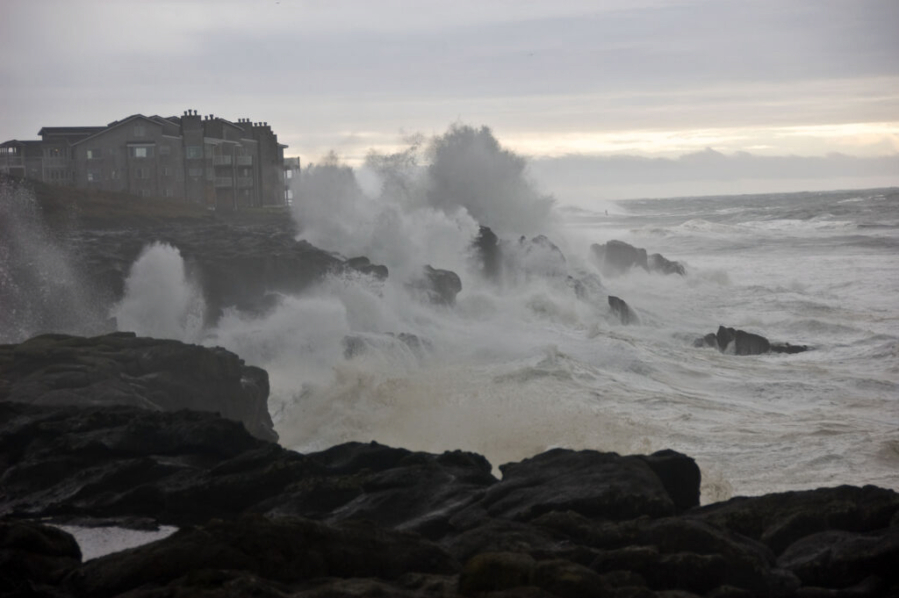A tropical weather system called El Niño is beginning its march up the coast of Oregon, bringing with it a warmer winter and inescapable heat for some marine life.
Oregonians on the coast could experience flooding from high tides and rising sea levels. In the mountains, areas hoping for snow are more likely to get rain, which could accentuate the drought plaguing the West. For aquatic species, warming ocean temperatures could spur a northern migration and could be deadly for plankton vital to salmon and other species up the food chain.
Spurred by a change in air pressure over the Pacific Ocean near the equator, El Niño last visited Oregon in the winter of 2018, and has occurred more than 20 times since 1950.
It is both an ocean and atmospheric weather pattern that touches all parts of the West.
The latest system, which recently reached the southern Oregon coast, is predicted to be among the fiercest in years, according to Oregon’s state climatologist, Larry O’Neill. There have only been three El Niños since 1970 that have reached the category of “very strong” as determined by the National Oceanic and Atmospheric Administration. The last one was in 1997.
“Generally the rule of thumb is that El Niño leads to drier, warmer weather,” he said. “In strong years, it’s led to warmer, wetter weather. We don’t know yet how robust those relationships are though.”
The system typically arrives in early September, reaches its peak in the winter and fades toward the spring of the following year.
Andy Bryant, a hydrologist at the National Weather Service, said that it’s likely that due to warmer temperatures, more of the precipitation in the mountains that usually comes down as snow in winter is likely to fall as rain instead. For communities and aquatic species that rely on mountain snowpack to hold onto precipitation that then melts and flows as water in spring, it could mean a much drier spring.
“We’ve had a very dry summer,” he said. “If we have below average snowpack, that could potentially exacerbate drought conditions.”
Effect on ocean
The warmer water that El Niño brings has more volume, likely causing higher tides and the potential for coastal flooding, according to Jack Barth, a physical oceanographer and executive director of the Marine Studies Initiative at Oregon State University. Barth and other scientists expect the sea level off the Oregon coast to rise this winter due to El Niño.
On Tuesday, the National Oceanic and Atmospheric Administration projected some coastal flooding in areas along the West Coast through the winter. On top of that, Oregon’s fearsest coastal storms occur in winter, along with the biggest tides of the year called “King Tides.” El Niño could amplify them. “Houses built too close to a cliff or slope can be undermined with a fair bit of erosion,” Barth said.
This fall and winter are also likely to be trying times for Oregon’s sea life.
About 50 miles off the coast, a mass of warm ocean water that’s been growing for the last six months has been kept from the shore due to “upwelling.” Wind from the north pushes warm surface water off of the Oregon coast, allowing colder water from below to rise and replace it.
In early October, the winds that cause that upwelling will die down, and that warm water off the coast will be able to move onto shore, according to Barth. Ocean temperatures off the coast are expected to rise as much as 15 degrees Fahrenheit. In past years when such heat blobs have formed and moved to shore, coastal ocean temperatures shot up within a day or two.
“Which is remarkable,” Barth said. “Imagine you’re in your house, and it’s 50 degrees or so Farenheit, and then instantly it goes to 70. That’s what these marine organisms are going to feel.”
Vulnerable species that survive will likely move farther North.
“We’re seeing things up here we don’t normally see. We see these pelagic crabs from Baja; tuna we don’t normally see,” he said.
Plankton, the base of the marine food web, are particularly sensitive to heat changes. If plankton suffer, the salmon that eat them suffer and the animals that eat the salmon suffer.
“The effects reverberate for years,” Barth said.
Oregon Capital Chronicle focuses on deep and useful reporting on Oregon state government, politics and policy. We help readers understand how those in government are using their power, what’s happening to taxpayer dollars, and how citizens can stake a bigger role in big decisions.



